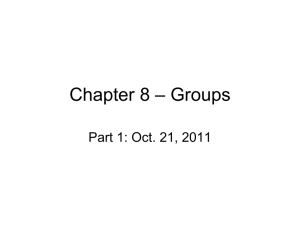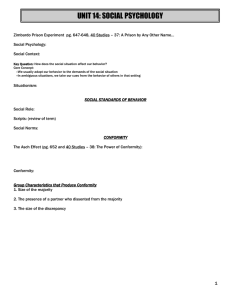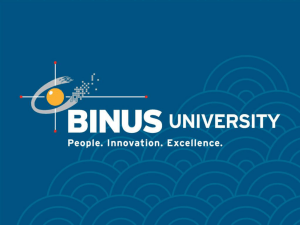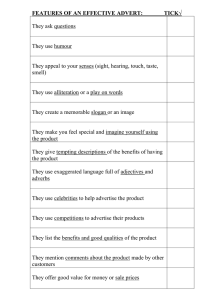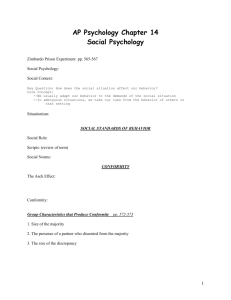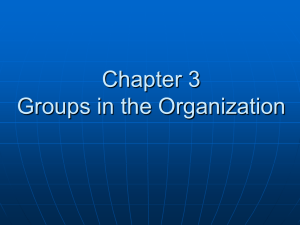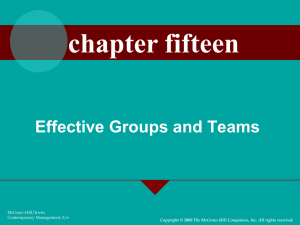Uploaded by
Rogersy L. Mangaba-Maltu
Group Behavior: Foundations, Dynamics, and Decision Making
advertisement
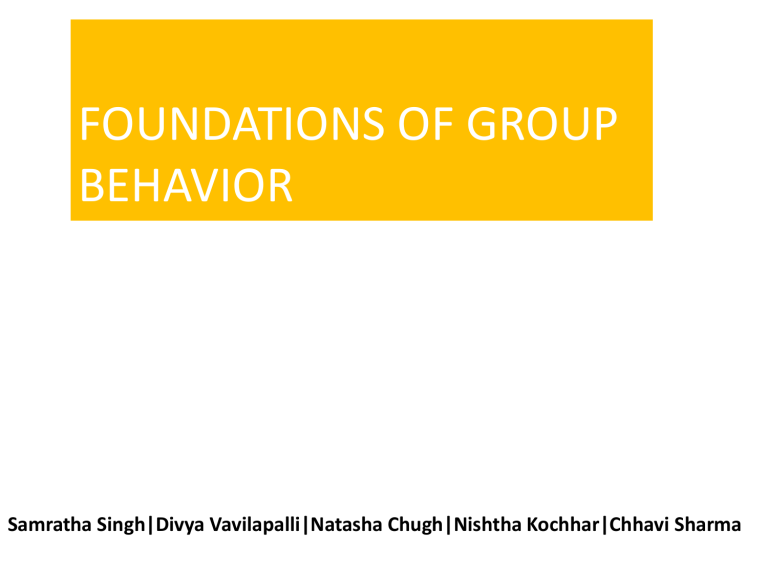
FOUNDATIONS OF GROUP BEHAVIOR Samratha Singh|Divya Vavilapalli|Natasha Chugh|Nishtha Kochhar|Chhavi Sharma A group is defined as two or more individuals, interacting and interdependent, who have come together to achieve particular objectives. –by Stephen Robbins Formal groups • A designated work group defined by an organisations structure, with designated work assignments establishing tasks Informal groups • It is an alliance which is neither formally structured nor organisationally aligned TYPES OF GROUPS INFORMAL GROUP FORMAL GROUP COMMAND GROUP INTEREST GROUP TASK GROUP FRIENDSHIP GROUP Why do people form groups? GROUP SYNERGY Group synergy refers to the idea that two heads (or more) are better than one. There is a saying, “The whole is greater than the sum of its parts,” which also refers to group synergy. Groups are often capable of performing higher quality work and making better decisions than an individual can make alone. Support and Commitment. A group is generally always being more willing to undertake a large project than would an individual. The group can provide encouragement and support to its members while working in a big project Interpersonal Needs. Individuals often join a group to meet their interpersonal needs. William Schutz has identified three such needs: inclusion, control, and affection. • Needs for inclusion Needs for inclusion is the need to establish self-identity with others. • Needs for control Needs for control is the need to exercise leadership and prove one’s abilities. • Needs for affection Needs for affection is the need to develop relationships with people. Group is an excellent way to make friends and establish relationships. STAGES OF GROUP BEHAVIOR 1. FORMING break the ice ; facilitate 2. STORMING conflict, disagreement ;resolve differences 3. NORMING order ; clarify roles and values 4. PERFORMING cooperation, problem-solving ; task accomplishment 5. ADJOURNING group disbands when goals are met Critique of the Five-stage Model Assumption: The group becomes more effective as it progresses through the first four stages -Not always true -Group behavior is more complex -High levels of conflict may be conducive to high performance -The process is not always linear -Several stages may occur simultaneously -Groups may regress Ignores the organizational context An Alternative Model: Temporary Groups with Deadlines Completion Performance (High) Sequence of actions: Phase 2 1. Setting group direction First Meeting 2. First phase of inertia Transition Phase 1 (Low) A (A+B)/2 Time Punctuated Equilibrium ModelTemporary groups go through transitions between inertia and activity. B 3. Half-way point transition 4. Major changes 5. Second phase of inertia 6. Accelerated activity GROUP PROPERTIES ROLES Perceptions Expectations Conflicts Norms Norms A set of assumptions or expectations held by members of a group or organization concerning what kind of behavior is right or wrong, good or bad, allowed or not allowed. Usually not articulated by groups members but they can state them if asked. Conformity A type of social influence involving expectations or a change in belief or behavior in order to fit in with a group. Study by Solomon Asch Deviant Workplace Norms Typology of Deviant workplace behaviour Performance •Coming late/leaving early •Working slowly •Being careless &making mistakes that lead to losses Material •Arson •Sabotage •Stealing Inter-personal •Being biased •Verbal Abuse •Being cynical and negative •Blaming others •Sexual Harassment Status Permeating every society, it is a socially defined position or rank given to groups or group members by others Status Norms Group Interaction Status Inequity SIZE The physical dimensions, proportions, magnitude or extend of an object. Smaller groups are faster at completing tasks than larger ones. Individuals perform better in smaller groups than large ones. In problem solving, larger groups consistently get better marks than their small counterparts. If the goal is fact finding- larger groups more effective. Smaller groups- doing something productive with that input. Social Loafing The tendency for individuals to expend (spend) less effort when working collectively than when working individually. CAUSES If one thinks others are lazy, the person reestablish equity by reducing effort. Dispersion of responsibility. Ways to prevent social loafing Set group goals Increase intergroup competition Engage in peer evaluation Select highly motivated people who prefer working in groups Base group rewards on each member’s unique contributions Cohesiveness The degree to which group members are attracted to each other and are motivated to stay in the group. Affected by: Time spent together by the group members Size- the smaller, the more cohesive External threats How to increase group cohesiveness? Make the group smaller Encourage agreement with group’s goals Increase the time members spend together Increase the group’s status and the perceived difficulty of attaining membership Stimulate competition with other groups Reward the group rather than individual members Physically isolate the group Diversity The degree to which members of the group are similar to, or different from, one another. GROUP DECISION MAKING It is a situation faced when individuals collectively make a choice from the alternatives before them. Two byproducts of group decision making Groupthink • A phenomena in which the norm of consensus overrides the realistic appraisal of alternative courses of action Group members rationalize any resistance to the assumptions they have made to, no matter how strong the evidence. Members apply direct pressure on those who express doubts about the options favored by the majority. Members who differ, keep silent. Illusion of unanimity,Abtension becomes a yes vote. Groupshift • A change in decision risk between a group’s decision and an individual’s decision that a member within the group would make; the shift can be toward either conservatism or greater risk. Whether the shift in the group’s decision is towards greater caution or more risk depends on the dominant pre-discussion norm. The risky shift The cautious shift -Group discussion makes decision situation more familiar -Diffusion of responsibilities -Risk persuaders -Desire for approval from others in the group. - less common than risky shift -Group discussion makes decision risk more clear -Personal acceptance of responsibility -Cautious persuaders Interacting Groups Brainstorming Typical groups in which members interact with each other face to face. An idea generation process that specifically encourages any and all alternatives while withholding any criticism of those alternatives Nominal Group Electronic meeting 1)Introduce and explain 2)Let members generate ideas silently 3)Share ideas 4)Discuss each idea in the group 5)Vote and rank ideas A meeting in which members interact on computers, allowing for anonymity of comments and aggregation of votes CASE STUDY Evan,Conner,Alexis,Derek and Judy had been team members for only one week, but they felt that they were already working well together. Upper management at their company, Advert, a medium –sized marketing firm, picked the five employees for a special project: the development of a commercial promoting the launch of a client’s 60inch plasma flat-screen television. The group of five was homogenous and they were given full autonomy to act. One member Conner took; leadership of the team, pushing up his readymade idea, the rest reacted passively preferring to keep team morale high rather than to discuss the issue. Though all the members did not have a positive opinion about the Conner’s idea they were subjected to groupthink and conformity. In a short time they completed the commercial and presented it to the client. The project was a failure, rejected by the client as it did not meet their needs. QUESTION 1 What factors contributed to the poor performance of the Advert team? As a manager, what could you have done to help the team perform better? QUESTION 2 According to the case, the Advert team was given a relatively high degree of autonomy. How might this autonomy have contributed to the presence of groupthink? QUESTION 3 Teams can either be homogenous or heterogeneous. How would you characterize the advert team , and how did this affect the team’s creativity and performance? QUESTION 4 What are some group decision making techniques that could have helped reduce conformity pressure and groupthink among the Advert team? QUESTION 5 What different forms of communication could have been employed to improve the sharing of ideas among Advert team? How might this have affected its performance and satisfaction? QUESTION 6 How would you describe Conner’s leadership style? Why do you think his style wasn’t effective? In what situations might Conner be an effective leader? CONCLUSION • In an organizational context, groupthink and group behaviour - important concepts as they determine the cohesiveness and coherence of the organizational culture and organizational communication. • Group think and group behaviour - powerful motivator and inhibitor. • The inhibitor works when employees feel that their individual creativity and brilliance are being sacrificed at the altar of conformity. • Need for a nuanced and balanced approach towards group behaviour to leverage the individual creativity and at the same time not sacrifice organizational cohesiveness and coherence. THANK YOU!
